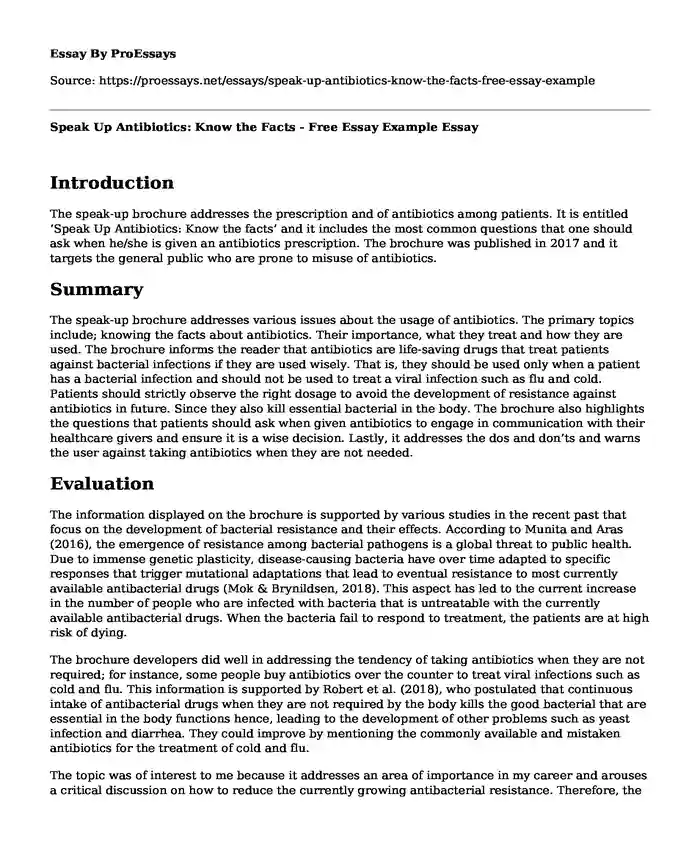Introduction
The speak-up brochure addresses the prescription and of antibiotics among patients. It is entitled ‘Speak Up Antibiotics: Know the facts’ and it includes the most common questions that one should ask when he/she is given an antibiotics prescription. The brochure was published in 2017 and it targets the general public who are prone to misuse of antibiotics.
Summary
The speak-up brochure addresses various issues about the usage of antibiotics. The primary topics include; knowing the facts about antibiotics. Their importance, what they treat and how they are used. The brochure informs the reader that antibiotics are life-saving drugs that treat patients against bacterial infections if they are used wisely. That is, they should be used only when a patient has a bacterial infection and should not be used to treat a viral infection such as flu and cold. Patients should strictly observe the right dosage to avoid the development of resistance against antibiotics in future. Since they also kill essential bacterial in the body. The brochure also highlights the questions that patients should ask when given antibiotics to engage in communication with their healthcare givers and ensure it is a wise decision. Lastly, it addresses the dos and don’ts and warns the user against taking antibiotics when they are not needed.
Evaluation
The information displayed on the brochure is supported by various studies in the recent past that focus on the development of bacterial resistance and their effects. According to Munita and Aras (2016), the emergence of resistance among bacterial pathogens is a global threat to public health. Due to immense genetic plasticity, disease-causing bacteria have over time adapted to specific responses that trigger mutational adaptations that lead to eventual resistance to most currently available antibacterial drugs (Mok & Brynildsen, 2018). This aspect has led to the current increase in the number of people who are infected with bacteria that is untreatable with the currently available antibacterial drugs. When the bacteria fail to respond to treatment, the patients are at high risk of dying.
The brochure developers did well in addressing the tendency of taking antibiotics when they are not required; for instance, some people buy antibiotics over the counter to treat viral infections such as cold and flu. This information is supported by Robert et al. (2018), who postulated that continuous intake of antibacterial drugs when they are not required by the body kills the good bacterial that are essential in the body functions hence, leading to the development of other problems such as yeast infection and diarrhea. They could improve by mentioning the commonly available and mistaken antibiotics for the treatment of cold and flu.
The topic was of interest to me because it addresses an area of importance in my career and arouses a critical discussion on how to reduce the currently growing antibacterial resistance. Therefore, the information provided in the brochure beneficial as it reflects the study as in the statement that “taking antibiotics when you don’t need them doesn’t make sense” (The Joint Commission, 2017). Therefore, I could incorporate the brochure in my patient education to help reduce the misuse of antibiotics. The information was precisely presented.
The information presented in the brochure supports current healthcare-related research as in Mok & Brynildsen (2018), who noted that timely and appropriate use of antibiotics will help in selective elimination of disease-causing bacteria while essential may recover after treatment; otherwise, treatment can be detrimental. The brochure targets people of all ages but nursing mothers, children and old people will benefit the most due to the possible weaknesses in their weak immunity. The information shall increase patient safety by warning them from the usage of over the counter antibiotics without clear prescriptions from a qualified health practitioner hence help in the fifth against the risk of antibiotic resistance.
Conclusion
The brochure addresses critical issues in antibacterial usage. They include: knowing the facts about antibiotics, usage and importance. It also addresses the abuse of antibiotics among patients who use them to treat viral infections such as flu and cold. It informs patients on the essence of should strict observation of the right dosage to avoid the development of resistance against antibiotics in future.
References
Mok, W. K. & Brynildsen M. P. (2018). Timing of DNA damage responses impacts persistence to fluoroquinolones. Proceedings of the National Academy of Sciences 115(27), pp. 6301-6309. DOI: 10.1073/pnas.1804218115
Munita, J. M., & Arias, C. A. (2016). Mechanisms of Antibiotic Resistance. Microbiology Spectrum, 4(2), 10. https://doi.org/10.1128/microbiolspec.VMBF-0016-2015
Robert, A., Nguyen, Y., Bajolet, O., Vuillemin, B., Defoin, B., Vernet-Garnier, V., Drame, M., & Bani-Sadr, F. (2017). Knowledge of antibiotics and antibiotic resistance in patients followed by family physicians. Medicine Et-Maladies Infectieuses, 47(2), 142–151. https://doi.org/10.1016/j.medmal.2016.10.003
The Joint Commission (2017). Antibiotics: Know the facts. https://www.jointcommission.org/resources/for-consumers/speak-up-campaigns/antibiotics-know-the-facts/
Cite this page
Speak Up Antibiotics: Know the Facts - Free Essay Example. (2023, Oct 23). Retrieved from https://proessays.net/essays/speak-up-antibiotics-know-the-facts-free-essay-example
If you are the original author of this essay and no longer wish to have it published on the ProEssays website, please click below to request its removal:
- Impact of Caffeine on Our Health Paper Example
- Principles of Professional Ethics for the Intelligence Community to Nursing Code of Ethics
- Facility Assessment: Gernon Brown Recreation Center
- Supplements for Strength-Power Athletes Paper Example
- Pressure Ulcer Management Among ICU Nurses in Saint Elizabeth Facility
- Essay on MA: Assessing Ecosystem Services for Human Well-Being
- COVID-19: A Global Economic Crisis on the Horizon? - Research Paper







